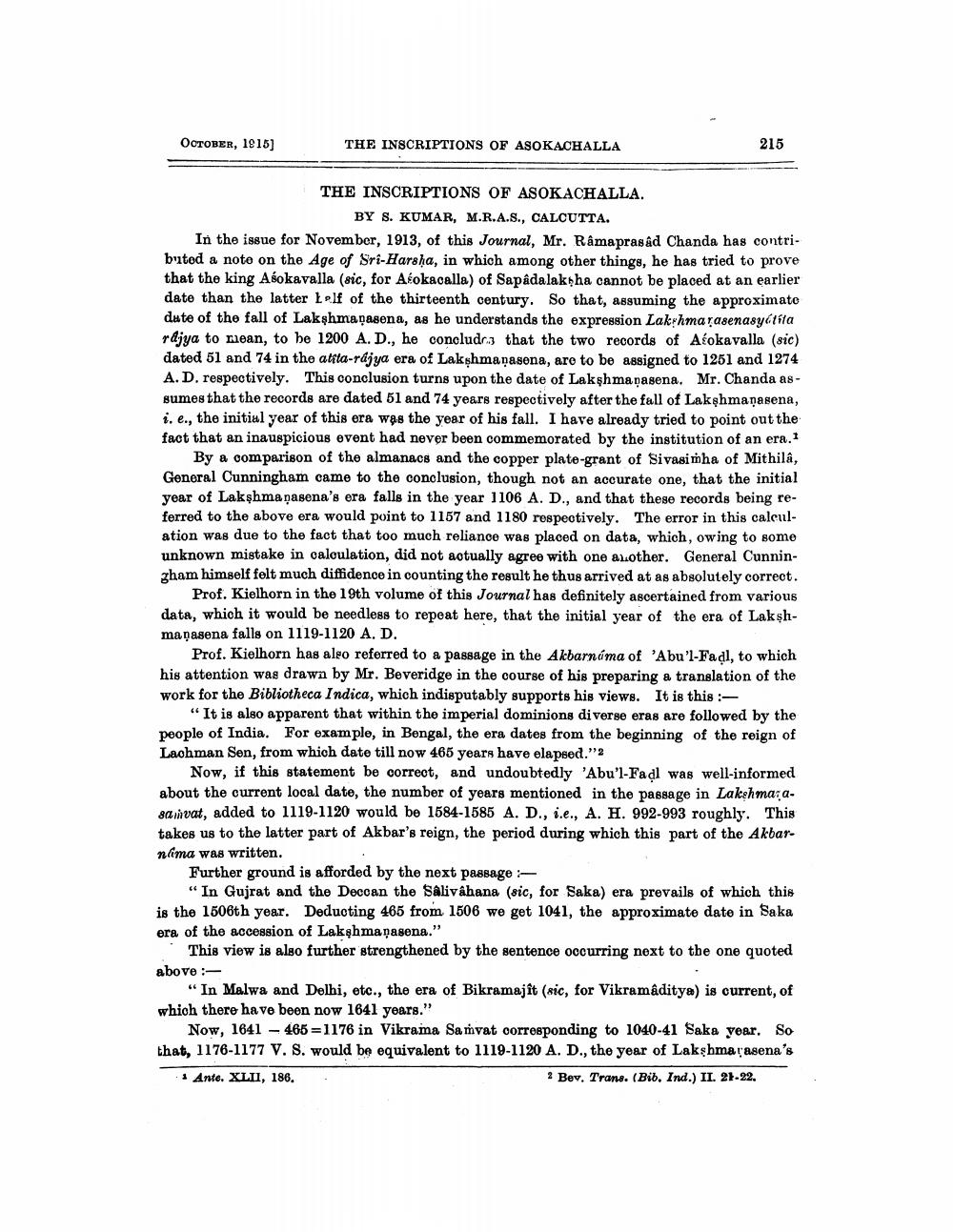________________
OCTOBER, 1915]
THE INSCRIPTIONS OF ASOKACHALLA
215
THE INSCRIPTIONS OF ASOKACHALLA.
BY S. KUMAR, M.R.A.S., CALCUTTA. In the issue for November, 1913, of this Journal, Mr. Ramaprasad Chanda has contributed a note on the Age of Sri-Harsha, in which among other things, he has tried to prove that the king Asokavalla (sic, for Asokacalla) of Sapadalakha cannot be placed at an earlier date than the latter kalf of the thirteenth century. So that, assuming the approximate date of the fall of Lakshmaṇasena, as he understands the expression Lakhmarasenasyátíta rdjya to mean, to be 1200 A.D., he concludr.3 that the two records of Alokavalla (sic) dated 51 and 74 in the atta-rajya era of Lakshmanasena, are to be assigned to 1251 and 1274 A. D. respectively. This conclusion turns upon the date of Lakshmanasena. Mr. Chanda as - sumes that the records are dated 51 and 74 years respectively after the fall of Lakshmanasena, i. e., the initial year of this era was the year of his fall. I have already tried to point out the fact that an inauspicious event had never been commemorated by the institution of an era.1
By a comparison of the almanacs and the copper plate-grant of Sivasimha of Mithila, General Cunningham came to the conclusion, though not an accurate one, that the initial year of Lakshmaṇasena's era falls in the year 1106 A. D., and that these records being referred to the above era would point to 1157 and 1180 respectively. The error in this calculation was due to the fact that too much reliance was placed on data, which, owing to some unknown mistake in caloulation, did not actually agree with one another. General Cunningham himself felt much diffidence in counting the result he thus arrived at as absolutely correct.
Prof. Kielhorn in the 19th volume of this Journal has definitely ascertained from various data, which it would be needless to repeat here, that the initial year of the era of Lakshmanasena falls on 1119-1120 A. D.
Prof. Kielhorn has aleo referred to a passage in the Akbarnáma of 'Abu 'l-Fadl, to which his attention was drawn by Mr. Beveridge in the course of his preparing a translation of the work for the Bibliotheca Indica, which indisputably supports his views. It is this :
" It is also apparent that within the imperial dominions diverse eras are followed by the people of India. For example, in Bengal, the era dates from the beginning of the reign of Lachman Sen, from which date till now 465 years have elapsed."2
Now, if this statement be correct, and undoubtedly 'Abu'l-Fadl was well-informed about the current local date, the number of years mentioned in the passage in Lakshma: a. sa invat, added to 1119-1120 would be 1584-1585 A. D., i.e., A. H. 992-993 roughly. This takes us to the latter part of Akbar's reign, the period during which this part of the Akbarnlima was written.
Further ground is afforded by the next passage -
“In Gujrat and the Deccan the Salivahana (sic, for Saka) era prevails of which this is the 1506th year. Deduoting 465 from 1506 we get 1041, the approximate date in Saka era of the accession of Lakshmanasena."
This view is also further strengthened by the sentence occurring next to the one quoted above :
"In Malwa and Delhi, etc., the era of Bikramajít (sic, for Vikramaditya) is current, of which there have been now 1641 years."
Now, 1641 - 465 = 1176 in Vikrama Samvat corresponding to 1040-41 Saka year. So that. 1176-1177 V. S. would be equivalent to 1119-1120 A. D., the year of Lakshmasasena's Ante. XLII, 186.
2 Bev. Trans. (Bib. Ind.) II. 21-22.




